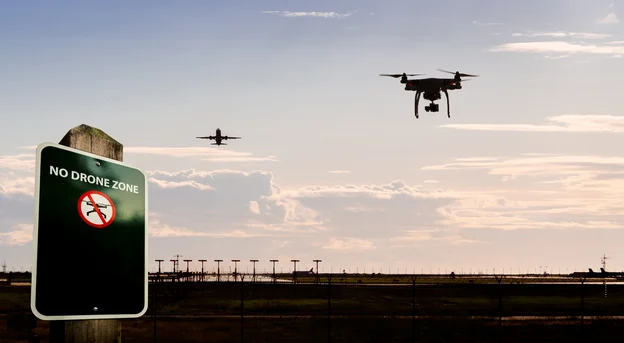The sky isn’t falling — it’s watching, smuggling, spying, and sometimes crashing.
Drones have soared from sci-fi fantasy to everyday reality — filming weddings, delivering groceries, and scanning farmland. But as these flying machines multiply in our skies, so do the threats they bring.
In India and around the world, drones are no longer just tools of convenience or innovation — they’re fast becoming instruments of disruption. From flight shutdowns at Bengaluru airport to suspected espionage near U.S. military bases, the risks are real, rising, and right above our heads. Simultaneously, the defence sector is pushing forward, with Aero India 2025 showcasing indigenous drone technologies, reflecting India’s strategic ambition in autonomous aerial systems.
As India eyes a $23 million drone market by 2030, it’s time to look beyond the promise — and confront the peril.
From innovation to intrusion
Espionage in the air: Armed with high-resolution cameras and advanced tracking capabilities, drones can easily become tools for unwarranted surveillance. From capturing unauthorised footage in sensitive areas such as military installations and government buildings, to monitoring individuals without consent, their misuse puts personal privacy at serious risk.In India, numerous residents have raised concerns about drones flying near apartment complexes and private properties, often with no clear accountability. With regulatory gaps still in place, such incidents leave citizens exposed and vulnerable to data breaches, or worse.
Skyborne smugglers: Drones have also become favoured tools for illicit activity. From smuggling contraband to launching cyber or even physical attacks, they present new challenges for law enforcement and defence agencies.
One alarming example: drones have repeatedly been used along the Punjab border to drop arms and narcotics from across the Pakistan side. These incidents have forced Indian security forces to enhance surveillance and deploy counter-drone technologies, highlighting how real and immediate the threat has become.
Threats to airspace and public security: Unauthorised drone activity in and around restricted airspace poses a serious threat to aviation safety. Globally, there have been multiple near-miss incidents where drones have interfered with commercial aircraft, disrupting operations and endangering lives.
In December 2023, for instance, flight operations at Bengaluru’s Kempegowda International Airport were briefly halted after an unidentified drone was spotted near the runway. The incident caused flight delays and highlighted alarming gaps in airspace monitoring and enforcement, gaps that regulatory bodies are still struggling to close consistently across regions.

Ethical dilemmas in modern warfare: Drones have become an integral part of contemporary warfare, enabling targeted surveillance and precision strikes. While this technology reduces human risk on the battlefield, it raises difficult ethical questions around civilian harm, accountability, and the automation of violence.
International human rights organisations have repeatedly flagged the use of drones in conflict zones like Syria and Yemen, where civilian casualties continue to mount. As militaries explore autonomous drones capable of independent decision-making, the lines between machine-led warfare and human ethics grow increasingly blurred, posing challenges that international law has yet to fully address.
Impact on wildlife and the environment: Beyond human conflict, drones are also quietly disrupting ecosystems. Wildlife experts have reported that drone noise and presence can cause stress and behavioural changes in animals, particularly during sensitive periods like mating or migration.
In India’s Gir National Park, drone activity has been shown to disturb lion prides, especially during breeding seasons, prompting concerns from conservationists. Moreover, with the surge in drone usage comes a spike in discarded parts and crashed devices, adding to the growing problem of electronic waste and threatening environmental sustainability.
Hacking the skies: Modern drones are flying computers — and like any connected device, they can be hacked. A compromised drone can be hijacked, used for spying, or turned into a backdoor into secure networks.
In one real-world demo, IBM researchers flew a drone over an office building to intercept Wi-Fi and steal data, without ever entering the premises. The message was clear: cyber threats can now come from above.
Futureproofing the skies
Drones carry incredible promise — but without proactive action, they also bring peril. As they weave deeper into our cities and lives, the need for bold, coordinated action becomes urgent. Regulation must get sharper, enforcement smarter, and awareness broader. Above all, we need cutting-edge systems ready to neutralise threats before they strike.
That’s where Indrajaal steps in — not just as a technology, but as India’s aerial shield. As the skies fill with possibility and risk, Indrajaal is redefining what it means to protect a nation from above. The future is flying — and we’re here to make sure it’s safe.
Learn more at indrajaal.in